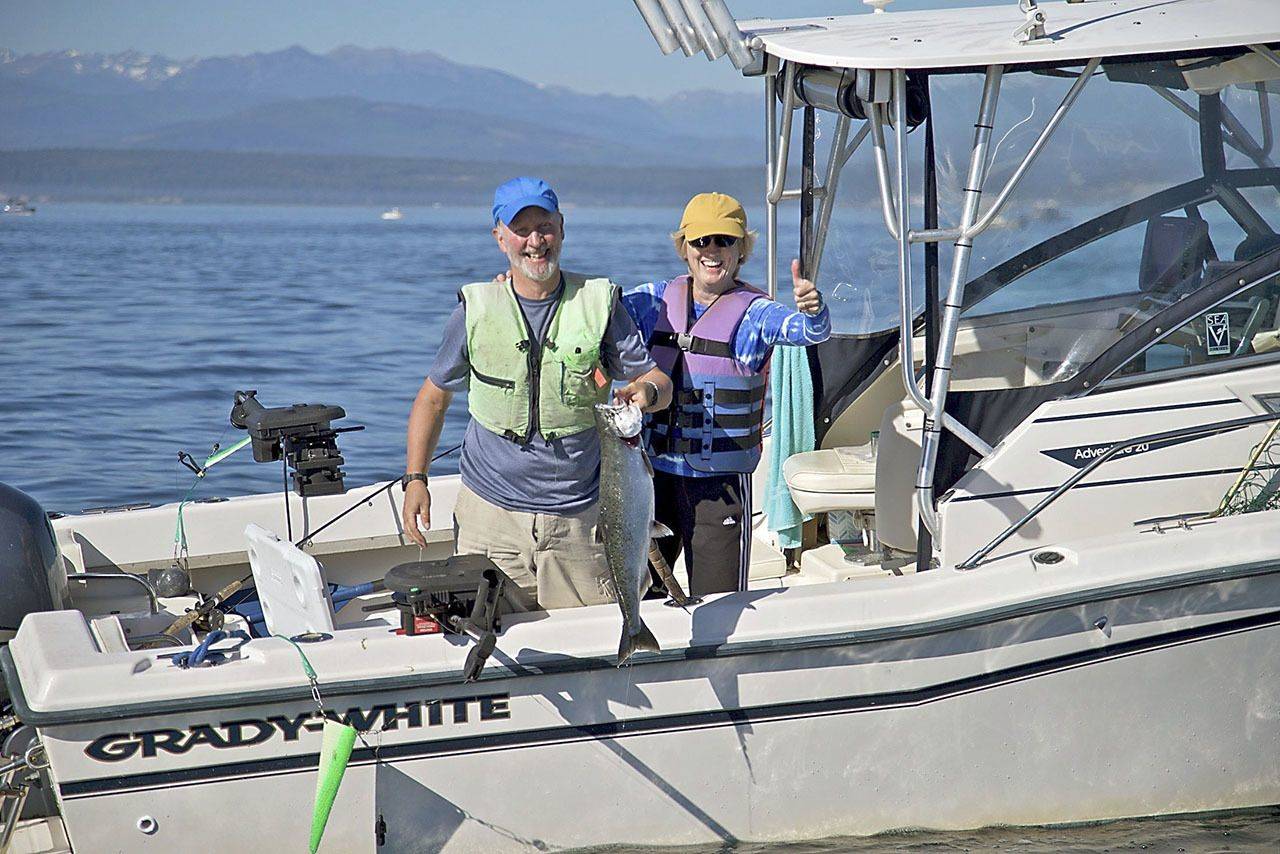GOOD AND BAD news comes with the release of finalized Pacific Ocean, Strait of Juan de Fuca and Puget Sound salmon seasons by the Pacific Fisheries Management Council and the state Department of Fish and Wildlife.
This year’s seasons reflect increased opportunity for hatchery coho along the Strait of Juan de Fuca and Puget Sound, but sizable cuts to chinook fisheries in the Pacific Ocean, the Strait and the Sound.
Let’s start with the bad, a 17,500-fish reduction in chinook quota for the recreational fisheries north of Cape Falcon.
“This year’s package includes some very restrictive seasons in both commercial and recreational fisheries along the entire coast,” said PFMC chair Phil Anderson.
Anderson was the director of Fish and Wildlife from 2009-15 and operates charter business on a part-time basis out of Westport.
“Low abundances of chinook and coho are in part due to the poor ocean conditions the adult fish faced as juveniles when they entered the ocean, and poor in-river habitat and water conditions,” Anderson said.
Ocean anglers will fish for 27,500 chinook in the recreational quota, down from 45,000 last year, and 42,000 coho (same as 2017).
Salmon fishing will open June 23 in La Push (Marine Area 3) and Neah Bay (Marine Area 4) and will end Sept. 3 or when the quota totals are reached.
In the La Push Subarea, anglers will have a 1,090 marked coho quota and a subarea guideline of 1,500 chinook.
This fishery will be open seven days a week with a limit of two salmon.
Anglers fishing out of Neah Bay will have the opportunity to target a 4,900 chinook guideline and a 4,370 coho subarea quota.
The Neah Bay fishery will be open seven days a week. All salmon may be retained, except no chum may be kept beginning Aug. 1. The limit is two salmon per day, no more than one of which may be a chinook.
Anglers also will have to send back chinook if they fish east of the Bonilla-Tatoosh line beginning Aug. 1.
Strait of Juan de Fuca
Inside the Strait of Juan de Fuca, Marine Area 6 [East Strait of Juan de Fuca] anglers will have to cool their heels until July 3 for the start of hatchery chinook and coho season, a loss of three days compared to initial forecasting. Area 6 also will switch to non-retention of chinook the last two weeks of August while remaining open for hatchery coho.
Marine Area 5 (Sekiu) will open for chinook and coho fishing July 1 with king retention running through mid-August and hatchery coho through the month of September.
That’s a gain of an entire month of coho in Marine Area 5, the best news for that unfortunately restricted fishery in the past few years.
For blackmouth, Marine Area 6 reopens Feb. 1 through April 15, while Marine Area 5 reopens in mid-February and will run through April 30.
Marine Area 9 (Admiralty Inlet) was allotted a chinook quota of 5,563 fish, similar to 2017’s 5,599 chinook quota and well above the 3,056 from 2016.
The bummer here is original models for Area 9 had a quota total of 7,300 chinook this season.
So expect the fishing to be fierce and short-lived (a month at most) around Mid-channel Bank when chinook retention begins July 16.
Marine Area 9 does see an improved hatchery coho season this year, with anglers able to retain coho from July 1 through September.
Last season saw Area 9 coho anglers restricted to shore fishing only from mid-August through early September.
A non-selective coho fishery will run in Hood Canal (Marine Area 12 north of Ayock Point starting September. Mark-selective chinook can be retained north of Ayock Point beginning Oct. 1.
Discussions over a mid-canal summer chinook season became a sticking point and went deep into Tuesday, but state and tribal co-managers couldn’t come up with a plan to take advantage of the thousands of hatchery fish returning to the George Adams Hatchery along the Skokomish River.
And the Skokomish River won’t be open for recreational anglers with the Skokomish Tribe dug in to their position that the river runs through the reservation boundaries and not alongside the reservation.
The closed area includes the section of river from the Tacoma Public Utilities power lines (near the mouth of the river) upstream to the Bonneville Power Administration power lines (upstream and west of U.S. Highway 101.
Fish and Wildlife staffers said environmental conditions and the loss of habit have constricted returns in recent seasons.
“A variety of unfavorable environmental conditions, including severe flooding in rivers and warm ocean water, have reduced the number of salmon returning to the state’s rivers in recent years, said Ron Warren, head of Fish and Wildlife’s Fish Program.
“In addition, the loss of quality rearing and spawning habitat continues to take a toll on salmon populations throughout the region, where some stocks are listed for protection under the federal Endangered Species Act, he said.
The habitat loss issue isn’t getting any better, either, in an area that adds more and more population each year.
“It’s critical that we ensure fisheries are consistent with ongoing efforts to protect and rebuild wild salmon stocks,” Warren said. “Unfortunately, the loss of salmon habitat continues to outpace these recovery efforts. We need to reverse this trend. If we don’t, salmon runs will continue to decline and it will be increasingly difficult to develop meaningful fisheries.”

